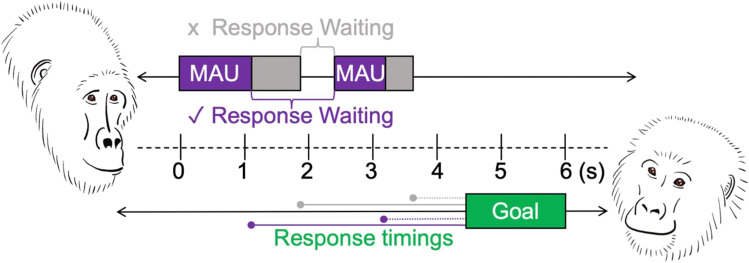Fig. 4.
Visualisation of different ways in which response latencies and inter-gesture intervals can be measured using the GesturalOrigins coding scheme. Note. Each communication can be viewed as a string of behaviours on a timeline that starts with the gesturing of one individual towards another and ends with a particular behavioural outcome (typically, either the goal of the signalling individual (ASO) or the failure of the communication). In this example of a simple gestural communication, individual A (the signaller) on the left gestures twice and individual B (the recipient) responds with an apparently satisfactory outcome (the ‘goal’ of the communication) after a certain amount of time has elapsed. If we take the inter-gesture interval as starting at the end of the gesture action duration and ending at the onset of the next gesture, it is < 1 s and would not meet the time-based cut off for response-waiting to be present and both gestures would be considered part of the same sequence. However, when investigating inter-gesture intervals and response-waiting times the end of the MAU may be of particular interest, because it approximates the point in time where all the necessary information for the gesture action to be understood as a case of this particular gesture action should be in place. If we consider the inter-gesture interval as starting at the end of the MAU and ending at the onset of the next gesture, the time-interval in this example is then > 1 s and would meet the time-based cut off for response-waiting, and the two gesture instances would not be part of the same sequence. Apart from inter-gesture intervals the coding scheme offers great flexibility in calculating recipient response latencies (see worked example 2). Some of them are indicated with purple and grey lines leading from different gesture end points to the Outcome (green goal box). Note that for the purpose of clarity and regarding the fact that the difference between gesture action duration and full gesture duration seems consistent and small (see worked example 1) no distinction is made between these two durations in the graph

